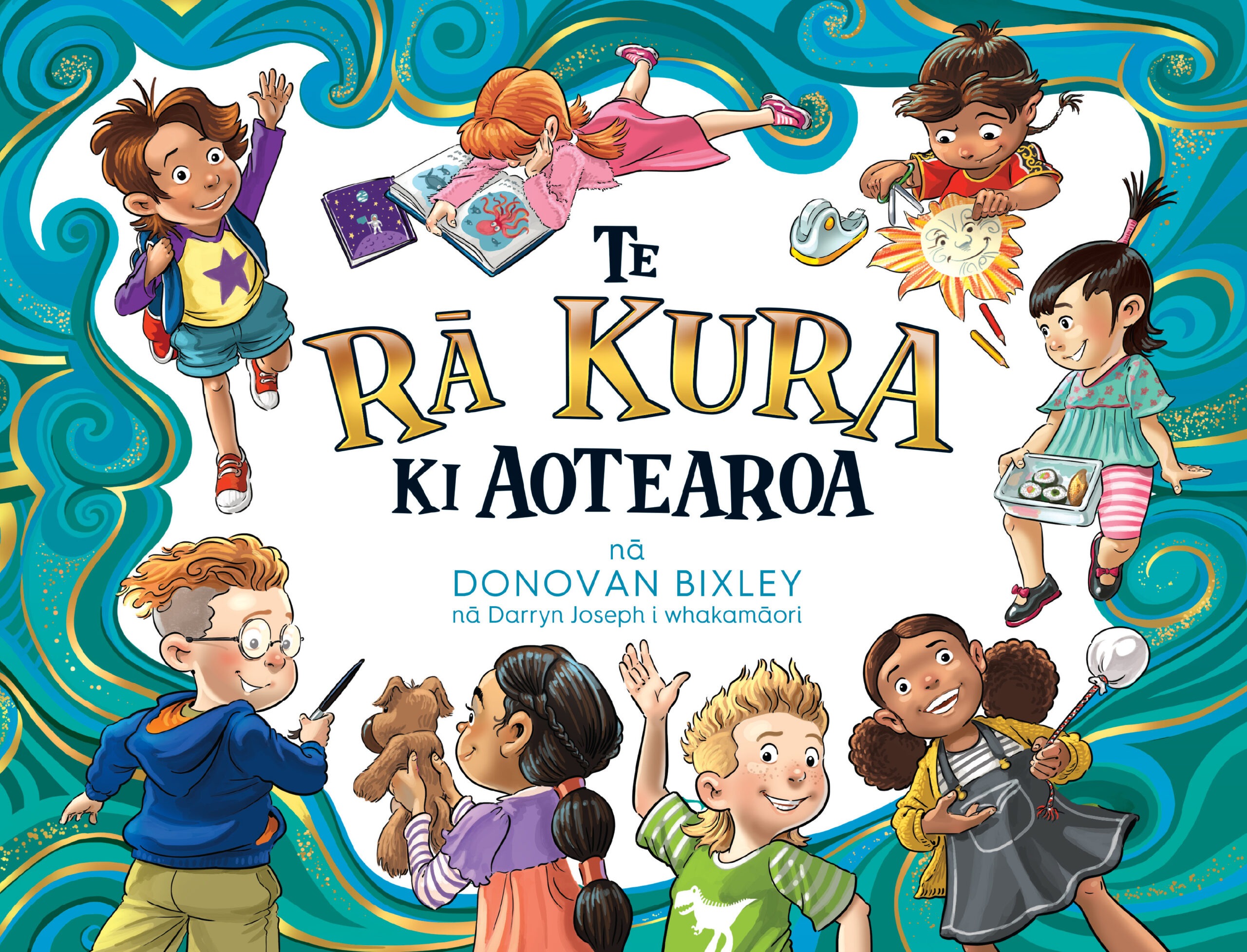For the Te Kura Pounamu finalists we asked the publishers why it was important to them to publish these particular books in te reo Māori, and our te reo editor Faith Tupou makes some comments as well. Read our comments on all the finalist categories here, and keep an eye out as we cover another NZCYA category next week!
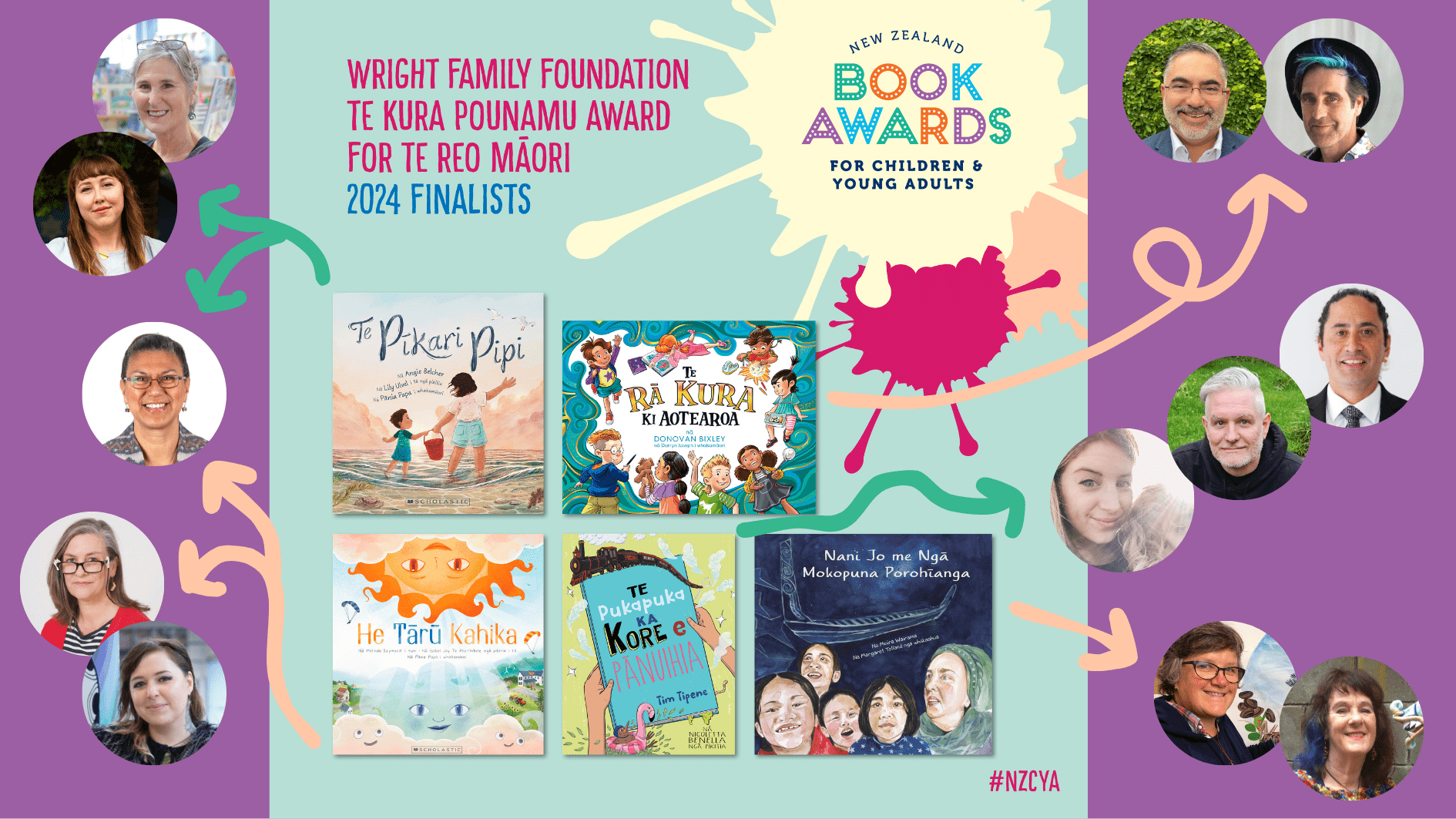
Scholastic NZ
He Tārū Kahika, nā Melinda Szymanik & Isobel Joy Te Aho-White, nā Pānia Papa i whakamāori
Scholastic New Zealand has been publishing picture books in te reo Māori for around 30 years, and we are proud to add these playful, relatable and fresh titles by Melinda Szymanik and Angela Belcher to our te reo list. The subject matter of Melinda’s story, He Tārū Kahika, is reminiscent of a traditional myth to explain a natural phenomenon, which we felt would fit well with te Ao Māori. We knew that Isobel Te Aho-White could provide a uniquely NZ touch in the illustrations, while still allowing this universal tale to be relevant overseas.
What our te reo editor Faith Tupou has to say:
This is a story of friendship that is literally up in the air! It features Ngā Kapua (Clouds) who are trying to arrange a meeting between Rā (Sun) and Ua (Rain). This proves difficult until they devise a plan which results in something spectacular.
The eyes of these characters are simple yet so expressive, thanks to the illustrator Isobel Joy Te Aho-White. There is a lot of detail in the birds-eye-view of the activity on the ground, people carrying on with their daily lives, at the marae, in the playgound, shopping, totally unaware of what is happening above them.
The glossary at the back of the book enables the reader to look up any unfamiliar kupu at a glance.
Scholastic have a list of award-winning books written by Melinda Szymanik, who has a background in science and shares some of that knowledge in a child-friendly manner.
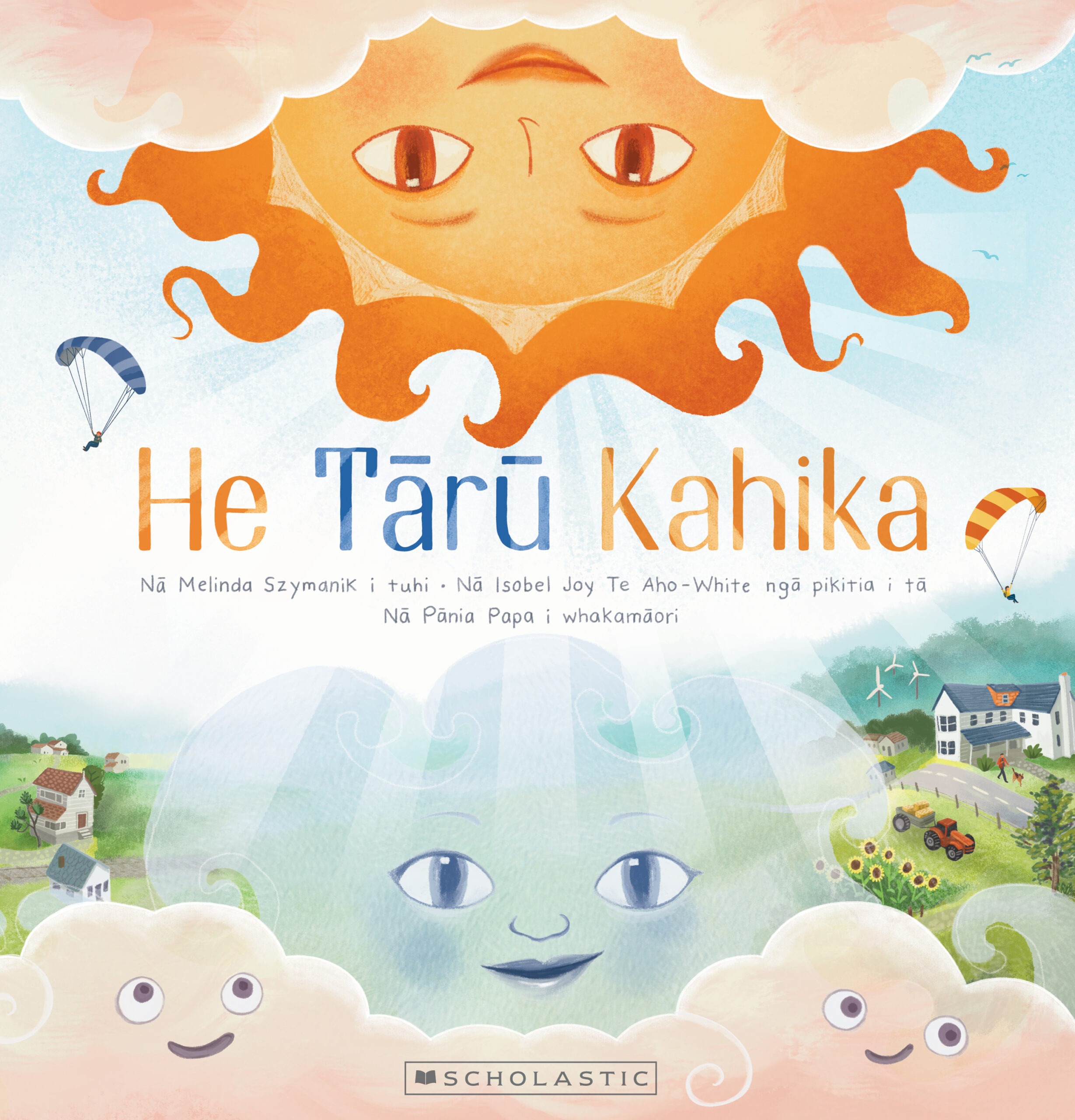
He Tārū Kahika
Nā Melinda Szymanik
Nā Pānia Papa i whakamāori
Nā Isobel Joy Te Aho-White i tā ngā pikitia
Scholastic NZ
With Te Pīkari Pipi, Angie Belcher and illustrator Lily Uivel have captured the fun of collecting shellfish at the beach, an activity enjoyed by many Kiwis, Māori, Pākehā or tauiwi; it’s a part of our collective summer experience, as well as being a key source of food in times past for Māori tūpuna, so we felt this book was perfectly suited for a reo Māori edition. The story features Māori characters and the English version of the story includes a smattering of te reo words that are commonly used in everyday life in Aotearoa.
What Faith has to say:
Angie Belcher is a seasoned author. The rhyme in Te Pīkari Pipi sounds like music when it is read aloud, pleasing to the ear. Pānia Papa has skilfully employed te reo Māori that has the same lyrical rhythm.
The illustrations of Lily Uivel beautifully captures the movement of the grass on the sand dunes, the gentle waves of the ocean and the hair blown by the breeze.
There will be many whānau who will have cherished memories of going to the beach, gathering pipi, steaming them open and relishing those salty morsels.
This pukapuka was recently reviewed by Lady Kataraina Pōkai in te reo and English.
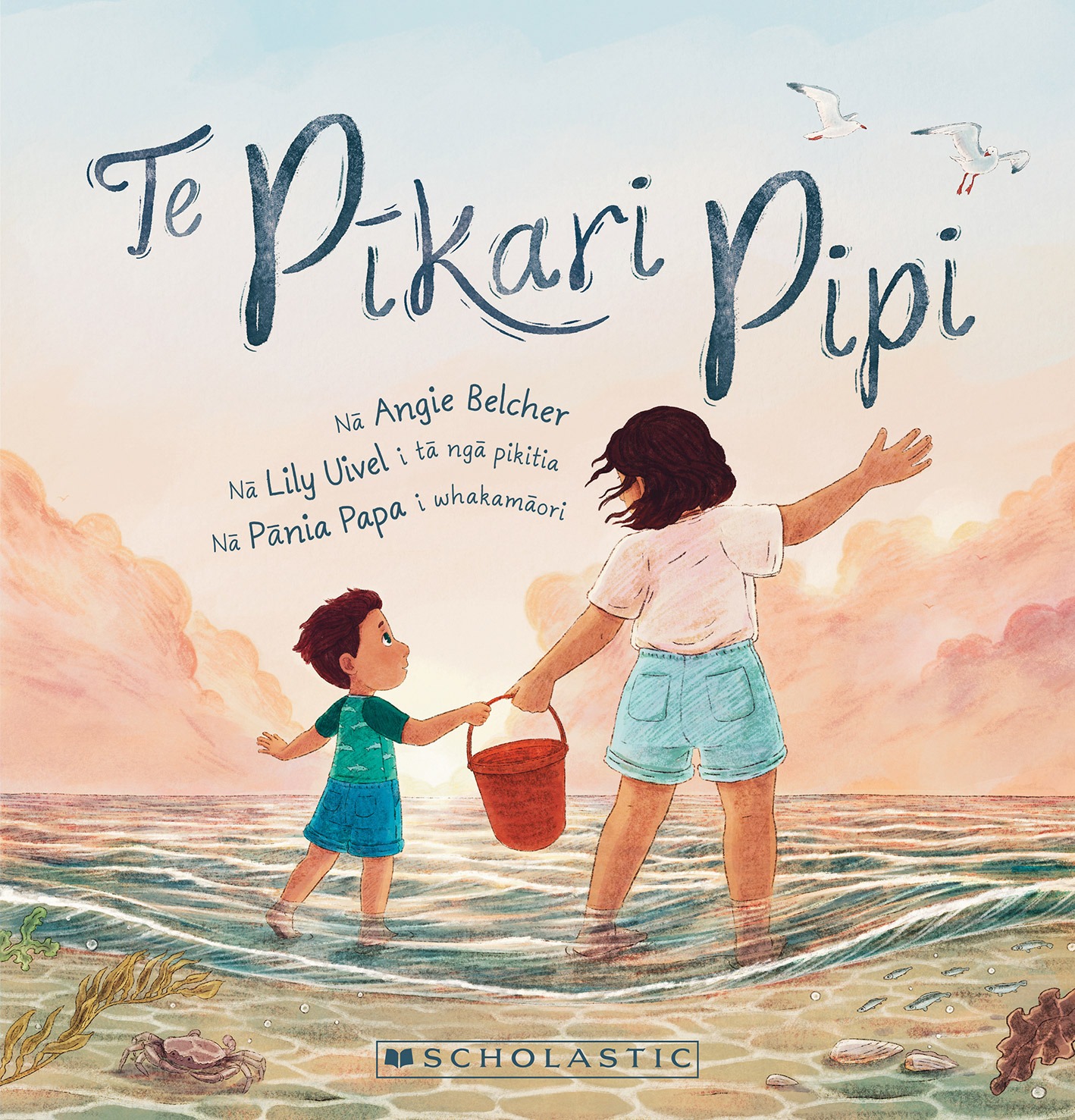
Te Pīkari Pipi
Nā Angie Belcher
Nā Pānia Papa i whakamāori
Nā Lily Uivel i tā ngā pikitia
Scholastic NZ
Oratia Books
Te Pukapuka ka kore e Pānuihia, nā Tim Tipene, nā Nicoletta Benella i tā ngā pikitia, nā Kanapu Rangitauira te whakamāoritanga
Te Pukapuka ka kore e Pānuihia was conceived of as a bilingual project from the outset. Author Tim Tipene has whakapapa to the iwi of Ngāti Kurī, Te Uri-o-Hau and Ngāti Whātua and all of his writing reflects that identity. Although this book has a universal theme that relates to children and readers everywhere, it’s very much based in Tim’s personal experience —reflecting his transformation from being a reluctant reader to an avid reader and a writer.
Author Tim Tipene has whakapapa to the iwi of Ngāti Kurī, Te Uri-o-Hau and Ngāti Whātua and all of his writing reflects that identity.
Because of its theme about discovering the joy of reading thanks to an amazing book with a life of its own, Tim and our editors did a lot of work to ensure young readers of all levels could read it comfortably without facing too much text on any page. While our recent books by Tim have been in one bilingual edition, in this case separate Māori and English editions were called for. It’s important that a reader in a Māori immersion setting can just as easily access Te Pukapuka ka kore e Pānuihia as a reader in an English-medium school can with The Book that Wouldn’t Read.
It’s important that a reader in a Māori immersion setting can just as easily access Te Pukapuka ka kore e Pānuihia as a reader in an English-medium school can with The Book that Wouldn’t Read.
The lovely illustration by Italian-Kiwi artist Nicoletta Benella has a New Zealand flavour but also communicates to an international readership. Having the fine translation by Kanapu Rangitauira (Te Arawa, Ngāti Porou, Te Whakatōhea) really grounds the Māori edition in our local landscape, and we hope will help bring Māori-speaking kids to the reading experience and reinforce their language-learning journey.
What Faith has to say:
‘He rerekē taua ingoa mō tetahi pukapuka, te kī a te tamaiti.’
“Strange name for a book,” said the boy as he chose his book from the library. Words went missing and sentences moved. This book was weird. Where was the story? There were some interesting creatures—including an ika oneone, also known as an axolotl.
There are lovely lyrical examples of onomatopoeia ‘I korā he pipopa, he wihi popa, he wupi wuu, he porotiti hoki’ There was a bebop, whiz pop, whoopy whoop and twirly whirly.’ The text in the book changes in font, size, and character, appearing to embody the words! Ka rawe!
Tim Tipene wrote from experience, and so he is able to empathise with tamariki who also face reading and learning challenges. Hopefully they will be encouraged to keep trying and be overcomers too!
The English version of this pukapuka was reviewed here by Kay Morfett.
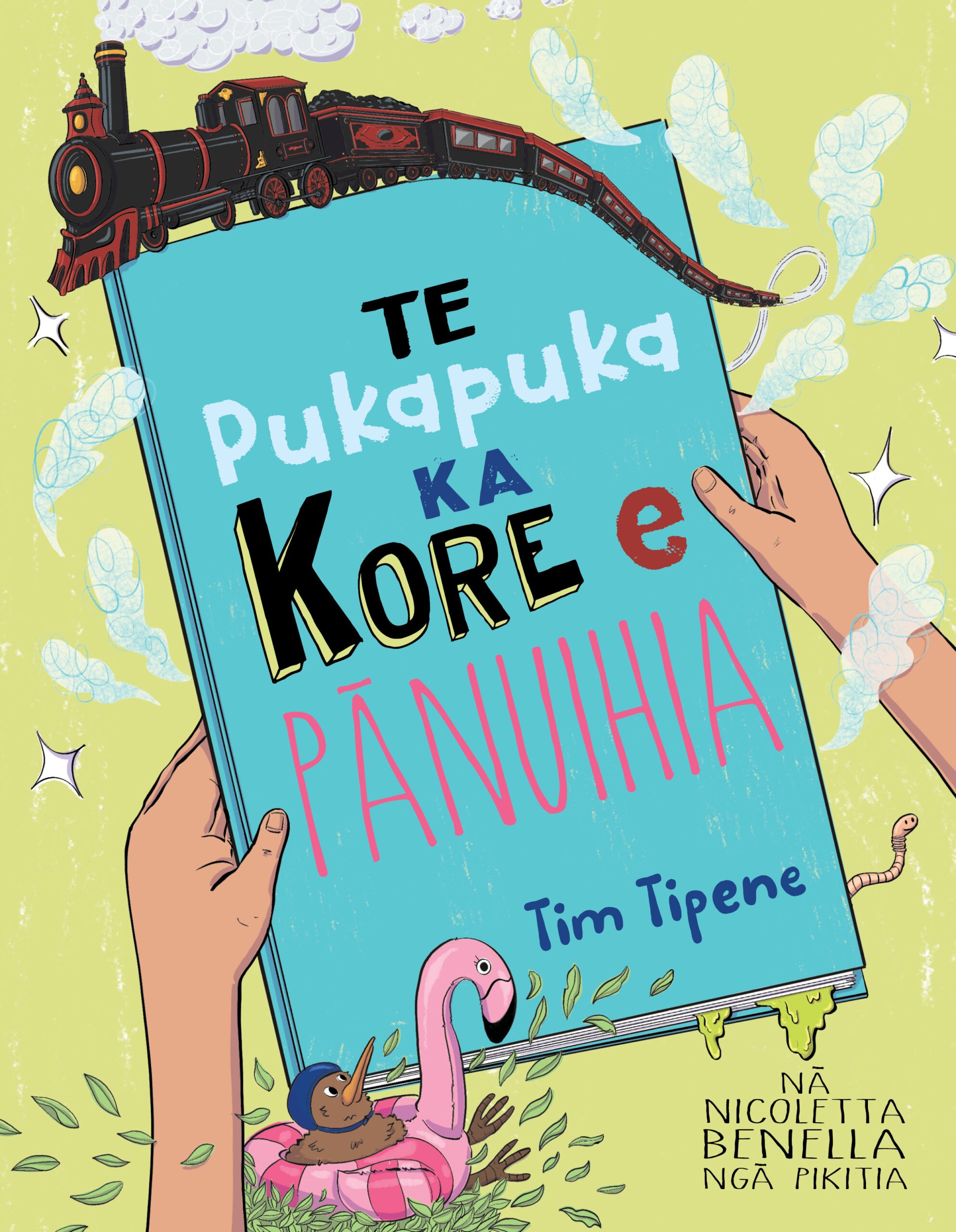
Te Pukapuka ka kore e Pānuihia
Nā Tim Tipene
Nā Kanapu Rangitauira te whakamāoritanga
Nā Nicoletta Benella i tā ngā pikitia
Oratia Books
Baggage Books
Nani Jo me Ngā Mokopuna Porohīanga, nā Moira Wairama, nā Margaret Tolland i tā ngā pikitia
I a au e timata ana hei kaiako, he ruarua noa iho ngā pukapuka reo Māori kua tāngia e te Tāhuhu o te Mātauranga hei rauemi whakaako mā ngā kura, pēnei i Te Wharekura, Te Tautoko, He Purapura, He Kohikohinga hoki. Engari, ahakoa kua tū ngā Kōhanga Reo me ngā kura kaupapa Māori i tērā wā, he torutoru noa iho ngā pukapuka reo Māori mā ngā tamariki i ngā kāinga me ngā whare pukapuka o Aotearoa.
He raruraru tēnei ki ahau. Ko tōku moemoeā he tuhi pukapuka tamariki ki ngā reo e rua o Aotearoa, engari ko te wero, kāore ahau e matatau ana ki te reo Māori. Heoi anō, ka waimarie au, ka ako i te reo ki Te Ataarangi. Ko Hiti Purewa tōku kaiako rangatira. Ka timata ahau ki te tuhi i roto i te reo Māori. I te tau 1993 i tuhia tētahi whakaari ki ngā reo e rua mō te School Journal, ā, i ngā tau 1998-2003 i tuhia ētahi kōrero ki te reo Māori mō He Purapura.
He mea āwhina taku mahi pukapuka nā Mokena Reedy, he kaituhi pukapuka tamariki, he koroua matatau hoki ki te reo me ngā tikanga Māori, ā, hei autāne mōku. Nāna ōku tuhinga i whakatikatika, ā ka piki tōku reo mō aku pukapuka Māori katoa. Ka tautoko mai hoki a Makaira Waugh, he hoa matatau ki te mahi ētita. He mihi nui tēnei ki a rātou nā te mea kua whā āku pukapuka tamariki ki te reo Māori ināianei kei roto i ngā kāinga me ngā whare pukapuka o Aotearoa. Mīharo!
*
When I started out as a kaiako in Māori medium education, there were a number of Māori readers that had been published by the Education Department. Thanks largely to Learning Media, these Māori readers increased in quantity and quality and also supported a growing number of new Māori writers. However, few te reo Māori picture and chapter books for tamariki are published outside the kura environment, books to be enjoyed in homes and libraries. My challenge as a writer, despite not being fluent in te reo Māori, is to write picture books in both English and Māori and help remedy that situation. And thanks to the people mentioned above, Nani Jo me Ngā Mokopuna Porohīanga is my fourth picturebook i te reo Māori. Miharo!
Moira Wairama kaituhi Nani Jo me Ngā Mokopuna Porohīanga.
…few te reo Māori picture and chapter books for tamariki are published outside the kura environment…
What Faith has to say:
Nani Jo enjoys taking her mokopuna porohianga out and about. They have lots of aroha for their Nani. ‘Tino aroha rawa atu ngā mokopuna porohianga ki a Nani Jo.’
However, Nani Jo becomes māuiui and she is not able to take them out anymore. She shares a pūrākau with them, about the fishing net of Taramainuku and Te Waka o Rangi. They delve a little further into matauranga Māori, how to locate Taramainuku and his Waka and what happens to the wairua of those people who have passed. They learn a karakia by Paka to mihi to Te Waonui a Tane and they acknowledge the appearance of Matariki.
The illustrations by Margaret Holland are crafted in a variety of styles depicting the whānau, their outings and the pūrākau, ka rawe ngā pikitia katoa!
As a kaiako in a Kura, Moira Wairama dreamed of writing picture books for tamariki written in te reo Māori and English to extend the books that were available. She co-founded Baggage Books along with Tony Hopkins and together they have produced six books.
Bee Trudgeon spoke to the author and illustrator here.
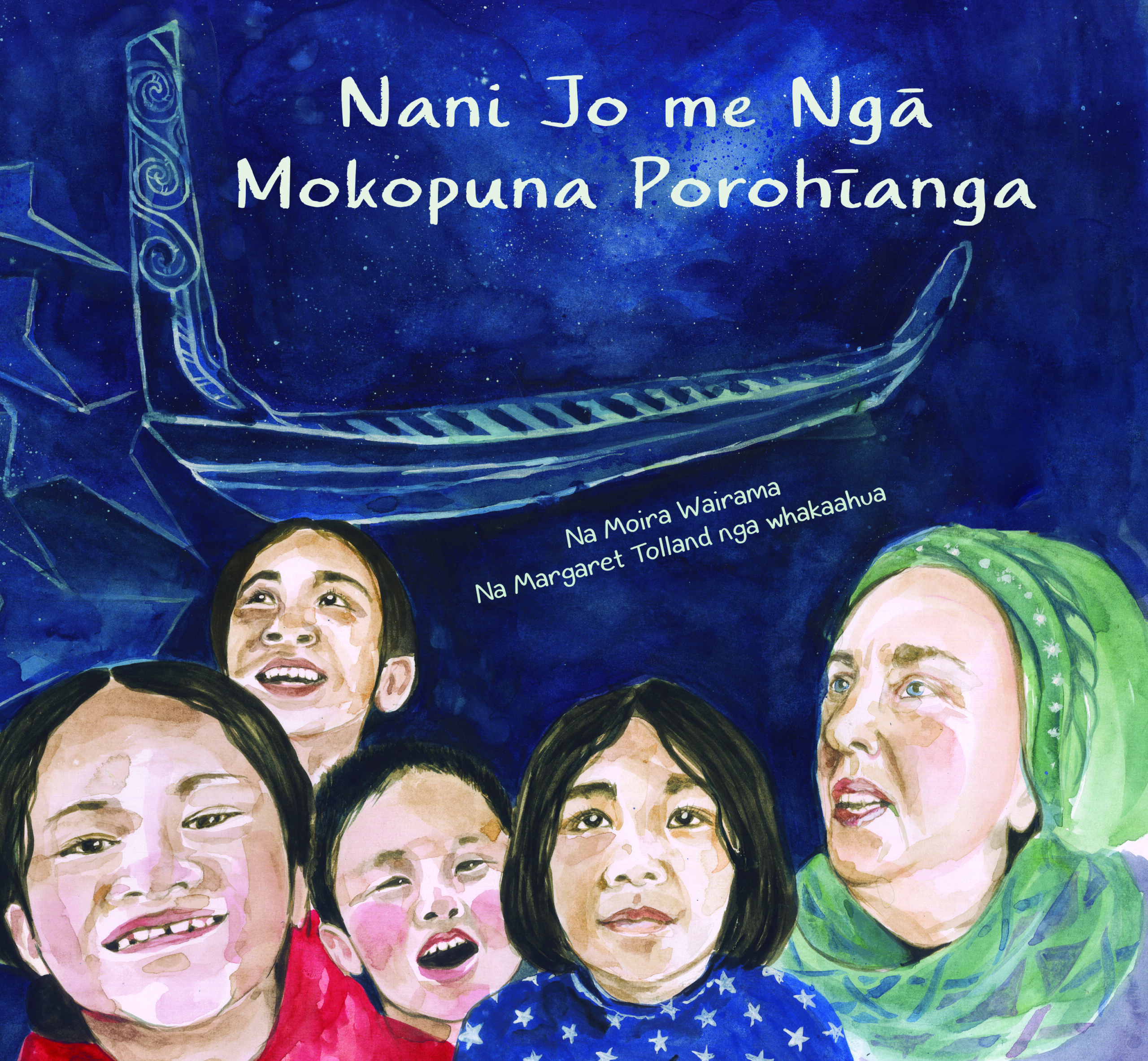
Nani Jo me ngā Mokopuna Porohīanga
Nā Moira Wairama
Nā Margaret Tolland i tā ngā pikitia
Baggage Books
Upstart Press
Te Rā Kura Ki Aotearoa, nā Donovan Bixley, nā Darryn Joseph i whakamāori
Upstart Press and Donovan Bixley agreed that, as far as possible, his picture books would be published simultaneously in English and te reo Māori to support the development of Māori language speakers in Aotearoa New Zealand. All sorts of families, regardless of language, face the same emotions when their child starts school so we’re glad that Te Rā Kura Ki Aotearoa is accessible for whānau who speak te reo. We’re also incredibly grateful to have the expert assistance of Darryn Joseph (Ngāti Maniapoto, Rereahu) who has both translated for and collaborated with Donovan on a number of titles.
All sorts of families, regardless of language, face the same emotions when their child starts school so we’re glad that Te Rā Kura Ki Aotearoa is accessible for whānau who speak te reo.
What Faith has to say:
‘Kei te haere au kia kite i te āhua o te kura.’
A postive start to kura, with so much to see and do, this pukapuka will appeal to early learning centres preparing their tamariki for transition to kura. Te Ao Māori is effortlessly interwoven into this story, panui i te reo Māori on the walls and fruitbowl. Tamariki swinging poi in time to the music. Listening to the pūrākau about Mauī and Tama-nui-te-Rā. Lots of examples given showing aroha ki te tangata, kaitiakitanga and manaakitanga, and all the important values being emphasised that will nurture tamariki to be kind, considerate and confidant akonga. ‘Axel’ is being fed by one of the akonga, it is not often that you meet two axolotl, with the first one being in E Kore Te Pukapuka ka Kore e Panuihia!
Upstart Press and Donovan Bixley continue their ongoing commitment in supporting te reo Māori, ngā mihi ki a koutou.
The English version of this pukapuka was reviewed by Annelies Judson here.
